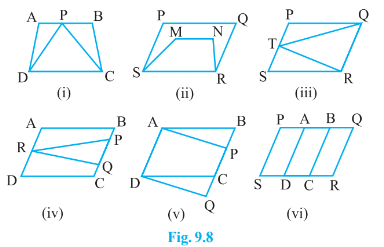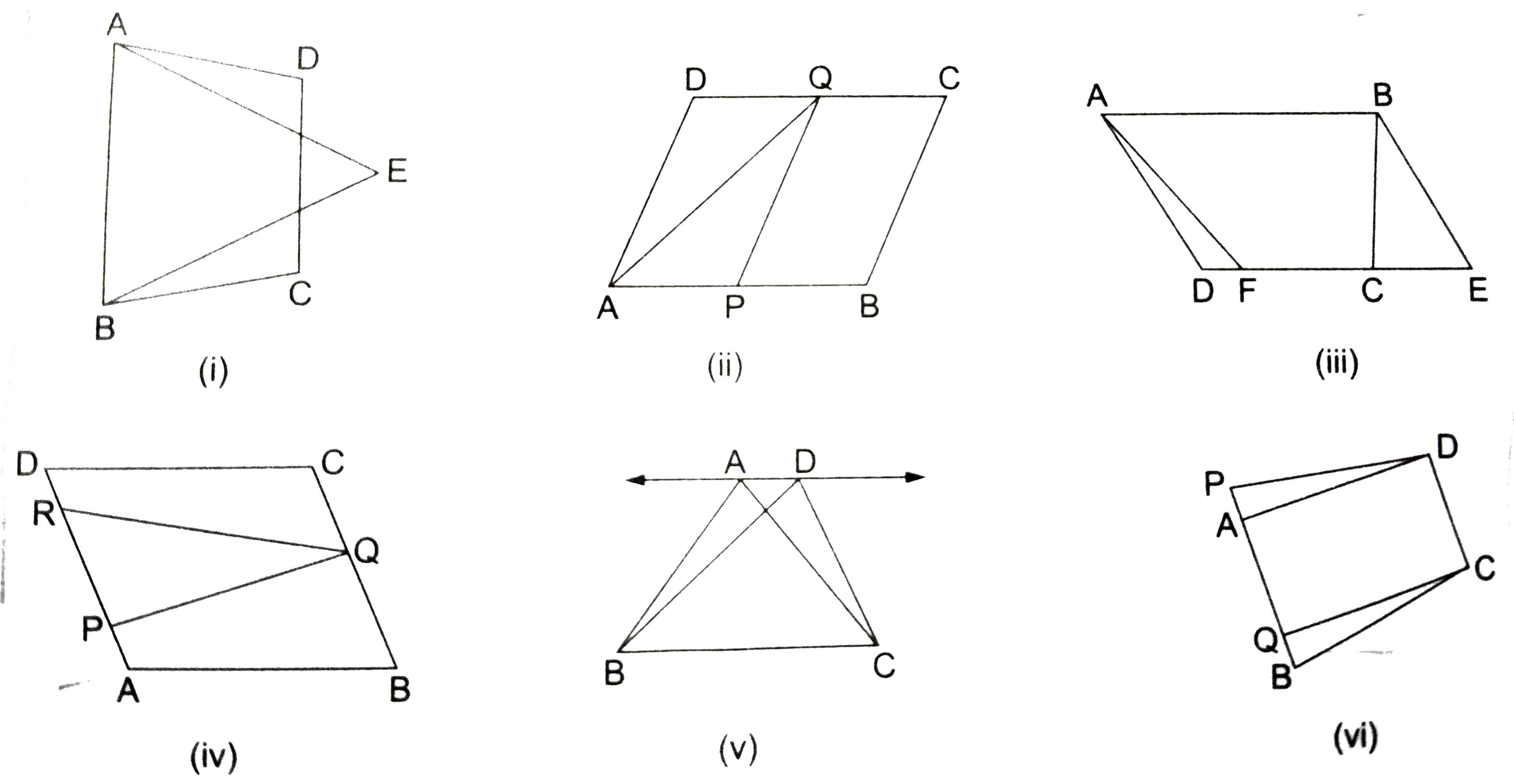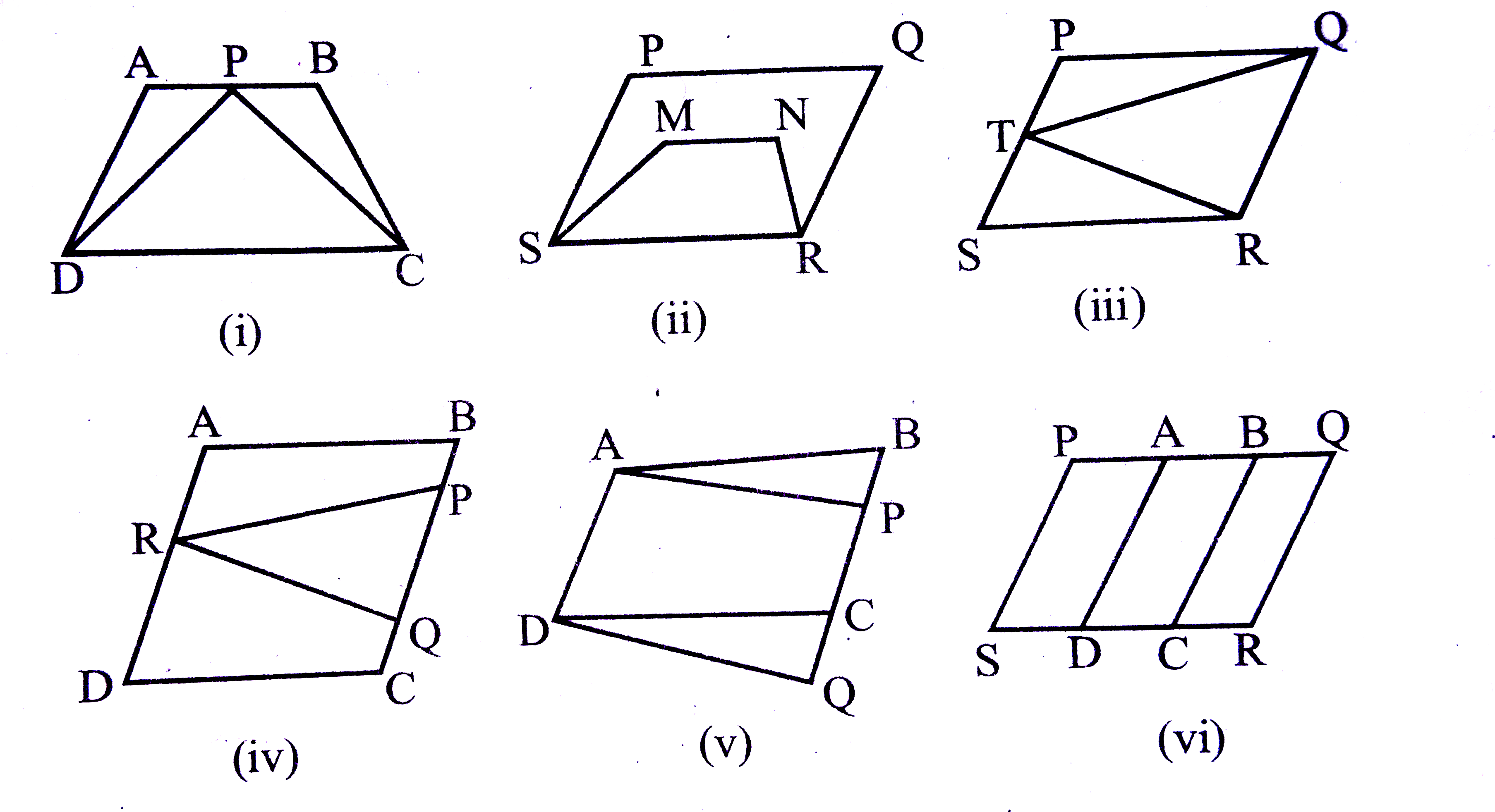Which of the following figures don't have equal areas if both the figures are on same base and between same parallels ?
Two parallelograms
One parallelograms and one rectangle
Two Triangles
One parallelogram and one triangle
The correct Answer is:D
To determine which of the following figures do not have equal areas when they share the same base and are between the same parallels, we will analyze each option step by step.
1. Understanding the Theorem:
- We know from geometry that if two figures share the same base and are between the same parallel lines, their areas are equal. This is particularly true for parallelograms and triangles.
2. Analyzing the First Option (Two Parallelograms):
- Let's consider two parallelograms, say ABCD and EFGH, which share the same base AB and are between the same parallels CD and GH.
- According to the theorem, since they have the same base and lie between the same parallels, their areas are equal.
3. Analyzing the Second Option (One Parallelogram and One Rectangle):
- Now, consider a parallelogram ABCD and a rectangle EFGH that share the same base AB and are between the same parallels CD and GH.
- Again, by the theorem, the area of the parallelogram will be equal to the area of the rectangle since they share the same base and are between the same parallels.
4. Analyzing the Third Option (Two Triangles):
- Next, we have two triangles, say ABC and DEF, which share the same base BC and are between the same parallels AD and EF.
- According to the theorem for triangles, their areas will also be equal since they have the same base and are between the same parallels.
5. Analyzing the Fourth Option (One Parallelogram and One Triangle):
- Finally, consider a parallelogram ABCD and a triangle EFG that share the same base AB and are between the same parallels CD and EF.
- In this case, the area of the triangle will not be equal to the area of the parallelogram. The area of the parallelogram is always greater than the area of the triangle when they share the same base and are between the same parallels.
Conclusion:
The figure that does not have equal areas when both figures are on the same base and between the same parallels is the fourth option: one parallelogram and one triangle.
---
- We know from geometry that if two figures share the same base and are between the same parallel lines, their areas are equal. This is particularly true for parallelograms and triangles.
- Let's consider two parallelograms, say ABCD and EFGH, which share the same base AB and are between the same parallels CD and GH.
- According to the theorem, since they have the same base and lie between the same parallels, their areas are equal.
- Now, consider a parallelogram ABCD and a rectangle EFGH that share the same base AB and are between the same parallels CD and GH.
- Again, by the theorem, the area of the parallelogram will be equal to the area of the rectangle since they share the same base and are between the same parallels.
- Next, we have two triangles, say ABC and DEF, which share the same base BC and are between the same parallels AD and EF.
- According to the theorem for triangles, their areas will also be equal since they have the same base and are between the same parallels.
- Finally, consider a parallelogram ABCD and a triangle EFG that share the same base AB and are between the same parallels CD and EF.
- In this case, the area of the triangle will not be equal to the area of the parallelogram. The area of the parallelogram is always greater than the area of the triangle when they share the same base and are between the same parallels.
The figure that does not have equal areas when both figures are on the same base and between the same parallels is the fourth option: one parallelogram and one triangle.
Topper's Solved these Questions
- AREAS OF PARALLELOGRAMS AND TRIANGLESBOOK - CBSE COMPLEMENTARY MATERIALCHAPTER - AREAS OF PARALLELOGRAMS AND TRIANGLESEXERCISE - PART-A (Fill in blanks :)
18 Videos
- AREAS OF PARALLELOGRAMS AND TRIANGLESBOOK - CBSE COMPLEMENTARY MATERIALCHAPTER - AREAS OF PARALLELOGRAMS AND TRIANGLESEXERCISE - Part-B
5 Videos
- CIRCLESBOOK - CBSE COMPLEMENTARY MATERIALCHAPTER - CIRCLESEXERCISE - PRACTICE TEST
3 Videos
Similar Questions
The area of a triangle is half the product of any of its sides and the corresponding altitude.
View SolutionShow that a median of a triangle divides it into two triangles of equal areas.
View SolutionEqual chords of a circle subtend equal angles at the centre.
View SolutionWhich of the following figures lie on the same base and between the same parallels.In such a case, write the common base and the two parallels.

View SolutionFigures on the same base and between the same parallels
View SolutionWhich of the following figure lie in the same base and between the same parallels. In such a case, write the common base and the two parallels.

View SolutionOut of the following given figures, which are on the same base but not between the same parallels?

View SolutionTheorem 9.3 : Two triangles having the same base (or equal bases) and equal areas lie between the same parallels.
View Solutionनिम्नलिखित आकृतियों में से कौन-सी आकृतियों एक ही आधार और एक ही समांतर रेखाओं के बिच स्थित है?ऐसी स्थिती में उभयनिष्ट आधार और दोनों समांतर रेखाएं लिखिय |

View SolutionWhich of the following figures lie on the same base and between the same parallels?
In such a cases, write the common base and the two parallels.

View SolutionWhich of the following figures lie on the same base and between the same parallels?
In such a cases, write the common base and the two parallels.

View SolutionWhich of the following figure lie on the same base and between the same parallels? In such a case, write the common base and two parallels: Figure (ii) Figure (iii) Figure Figure (ii) Figure (iii) Figure
View SolutionIntroduction||Congruent figure||if two figure are congruent then Area and Parimeter are same||Area OF part is equal to sum OF part various figure on the Same base Between Same parallel line||Discussion OF Exercise- 9.2
View SolutionWhich of the following figures lie on the same base and between the same parallels. In such a case, write the common base and the two parallels.

View SolutionWhich of the following figures lie on the same base and between the same parallels. In such a case, write the common base and the two parallels.


View Solution
